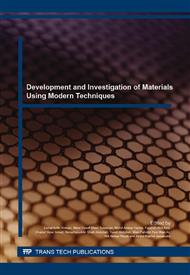[1]
S. Maensiri, P. Thongbai, And T. Yamwong, Giant Dielectric Response In (Li, Ti)-Doped NiO Ceramics Synthesized By The Polymerized Complex Method, Acta Mater., 55 (2007) 2851–2861.
DOI: 10.1016/j.actamat.2006.12.024
Google Scholar
[2]
S. Xue, J. Wang, S. Liu, W. Zhang, L. Tang, And B. Shen, Effect Of The Ba / Na Ratio On The Microstructure and Dielectric Properties of (Bao, Na2O ) – Nb2O5 – SiO2 Glass – Ceramics, Ceram. Int. 40 (2014) 7495–7499.
DOI: 10.1016/j.ceramint.2013.12.100
Google Scholar
[3]
J. Wang, G. Liu, B. W. Jia, X. Q. Liu, And X. M. Chen, Giant Dielectric Response and Polaronic Hopping in Al-Substituted A5/3Sr1/3NiO4 (A ¼La, Nd ) Ceramics, Ceram. Int., 40 (2014) 5583–5590.
DOI: 10.1016/j.ceramint.2013.10.150
Google Scholar
[4]
S. Manna And S. K. De, Giant Dielectric Permittivity Observed in Li And Zr Co-Doped NiO, Solid State Commun. 150 (2010) 399–404.
DOI: 10.1016/j.ssc.2009.11.044
Google Scholar
[5]
S. Lee, Dielectric Properties of (Ba, Sr , Ca) TiO3 Ceramics Modified With MgO for Phased Array Applications, J. Korean Phys. Soc., 41 (2002) 129–133.
Google Scholar
[6]
O.P. Kulshreshtha, A. Chamola, and A. Pal, Effect of Sr on Structural and Dielectric Properties of Lead Lanthanum Zirconate Titanate Perovskite Ceramics, International Journal of Educational Planning & Administration, 2 (2012) 97–108.
Google Scholar
[7]
K. Ramam And K. Chandramouli, Dielectric And Piezoelectric Properties of Combinatory Effect Of A-Site Isovalent And B-Site Acceptor Doped PLZT Ceramics, Ceram. – Silikáty, 53 (2009) 189–194.
Google Scholar
[8]
I.I. Lakin, A. Zakaria, Y. Abdollahi, D. Umaru, and M. Synthesis, Effect of Sintering Temperature On Microstructure And Electrical Properties of ZnO + CaMNO3 Ceramics Used In Low- Voltage Varistors, Digest J. Nanomaterials Biostructures, 10 (2015).
Google Scholar
[9]
M. Buchi Suresh and J. Roy, The Effect Of Strontium Doping On Densification and Electrical Properties of Ce0. 8Gd0. 2O2 Electrolyte for it-SOFC Application, Ionics (Kiel). 18 (2012), 291–297.
DOI: 10.1007/s11581-011-0633-4
Google Scholar
[10]
S. Mahabub A. B., Sheikh M.Q., Effect Of Sintering Temperature on Kicrostructure and Magnetic Properties of NiFe2O4 Prepared From Nanosize Powder of NiO And Fe2O3, J. Bangladesh Acad. Sci. 34 (2010) 189–195.
Google Scholar


